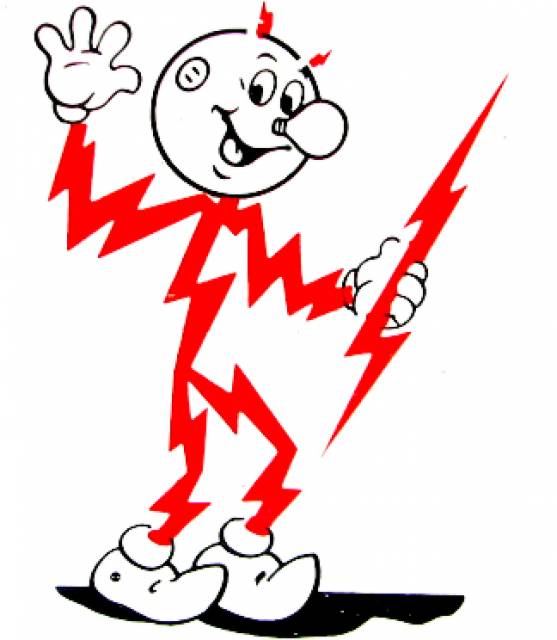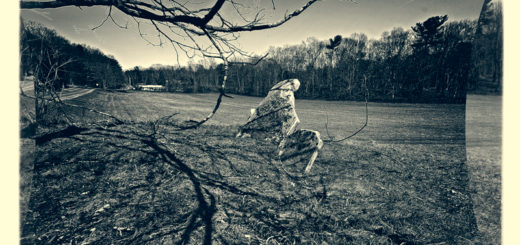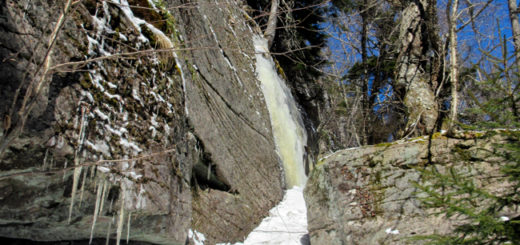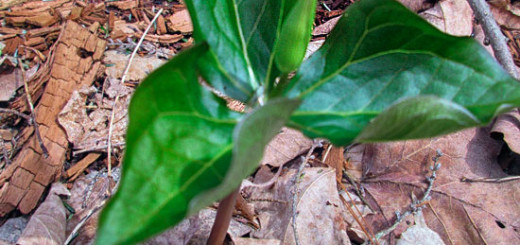Bodega Head: An Excursion in Nuclear Shamanism
They called it the “Glory Hole.” Seventy-three feet deep, one hundred forty-two feet in diameter. It took two expensive years of excavation to open the hole, the work being completed in October 1963. Spoils from the site had been used to construct an access road across the tidal mud flats at the northern end of the bay. Along the scarified shoreline of Campbell Cove, heavy equipment stood poised, ready to begin the next phase of construction. Final federal approval, expected at any moment, was all that remained between this and the earnest work.
The place, about 60 miles north of San Francisco, is called Bodega Head, but on a map it looks more like a thumb. Connected to the mainland by a wide, undulating east-west trending series of sand dunes, Bodega Head is a rocky spit of land, two-miles long by half a mile wide, jutting southward into the Pacific Ocean. Yet more than sand separates this block of quartz diorite from the sedimentary bulk of northern California: the dunes make manifest to the discerning eye the rift zone of the San Andreas fault.
Geologists speak of California as “tectonically active,” but in the early 1960s this part of the state was active in other ways. There were designs on the Head. It had been bored. Now it was ready to receive its crown: a 61 million dollar atomic power plant. With a generation capacity of 325 megawatts, it was to have become the largest nuclear generating station in the United States, the first to cross the threshold of commercial profitability.
But all of this was not to be.
There was strong grass-roots opposition to the plans for a reactor at Bodega Head. People worried about the San Andreas fault. The thought of building a nuclear reactor in such a location was unsettling. Although this particular section of the fault is quiet most of the time, during the 1906 quake that devastated San Francisco the ground here shifted a full ten feet. Debate over the issue was intense, but in the end the power company withdrew its application for a license to build and operate a nuclear generating station at Bodega Head. “We would be the last,” a 1964 press release assured an increasingly wary public, “to desire to build a plant with any substantial doubt existing as to public safety.”
Today Bodega Head is a state park. The “Glory Hole” is a freshwater pond. The scarified land has recovered into a fragrant mosaic of grassland, coyote bush, cow parsnip, and poison oak. The edges of the pond are thick with cattails and rushes. Only a keen landscape sensibility would be able to detect signs of the previous near-plutonic goings-on. Persephone has returned to the daylight, at play once again amid the blooms.
* * * *
Some years ago I attended a conference on “California Power Places” in the hills above the Napa Valley. One session was led by a woman named Lynne. By avocation a horticulturist specializing in California native plants, she made her “real money” as a technical writer for one of the computer companies in the Silicon Valley. Ordinary looking, slightly overweight, Lynne was in her mid-fifties. She dressed like an old hippie. One got the impression that this was her weekend wardrobe.
The session focused on “spirit of place.” The Romans had a term, genius loci, to refer to the divinity that resided in a particular locale. The genius of a place—like that of a human—is a higher and more spacious form of presence, whose extent no one quite knows. The goal of our session was come up with ways that we in the modern world might reestablish contact with these local divinities. “We must be practical,” our session leader admonished us, “not theoretical. The spirits are very down-to-earth.”
To encourage the group to talk about our own experiences, no matter how strange they might be, Lynne shared a story about an encounter she had with one of those outcrops of chert (locally referred to as “knockers”) on the western slopes of Mt. Tamalpais. She was walking along through the steep grassland with her friend Bill when she suddenly heard what sounded like voices rising from between the rocks. She felt the need to stop and investigate. Though hearing nothing himself, Bill was used to his companion’s endearing eccentricities, so he provided support.
“I’m going down,” she announced, and promptly got on hands and knees and—like a dabbling duck dipping in the water—stuck her head down between the rocks, her bottom up toward the sky. The next thing Bill knew, Lynne was flying up and backwards, as if tossed. She landed on her butt in the grass. Having suffered no major injury, she did have a slight bruise on her forehead, what looked like a small dent.
“They whacked me!”
“Who whacked you?”
“The spirits in those rocks.”
Lynne reported that when she stuck her head between those rocks, she suddenly found herself peering down, as if from the ceiling of a vast cavern, into a realm where shadowy, gnome-like figures were flitting about in a great commotion.
“They were not happy to see me,” she explained. “One of them stood underneath me and threw a fist up at my forehead. That sent me right back up into our world.”
Blessed with a healthy curiosity, Bill himself investigated the rocks. He found no portal to the underworld, only the solid earth. Yet he believed Lynne’s story. Over the years he had seen her tossed up from other rocks—as well as from stumps, tombstones, and one time an apartment complex dumpster. Her world was loud with voices that otherwise go unheard. She lent them her ear. Bill, that durable witness, had seen enough of this ordinary woman’s extraordinary encounters with the world to have faith in her experience.
Yes, this woman Lynne, who had a normal nine-to-five job and grew flowers on the weekend, was “crazy”—I came away from the session with a profound sense of that—but it was a refreshing craziness, one that punctuates day-to-day routine with a sense of wonder. Something blossoms in Lynne that is missing from the corporate, academic, and government worlds that comprise our mainstream culture. She has a playful style of being that does not lay waste to the full human power of perception. She regularly obtains glimpses of things that leave her open to public ridicule and secret envy. She is nuts, though perhaps only on the weekend.
So I told her—why not?—about the time I saw a whole New England graveyard of ghosts leap up from the ground and chase me as I drove my car down an isolated road. I was terrified at the time, not so much of the ghosts but that somehow it would be found out that I saw ghosts. I drove on toward my destination with hasty determination.
“They must have had something important to tell you,” Lynne now endeavored to explain. She chastised me for not stopping for those spirits radiating out of the eastern Maine landscape who, for reasons that remain tucked in their graves, wanted to have a word with me.
I came away from that session energized. There amid the live-oaks and aromatic laurels of an incandescent October afternoon, I experienced a catharsis, I who have spent much of my adult life under the fluorescent lights of the university. For the first time in a long while I felt an alignment between the inner and outer worlds. In the end, can it be said that this woman Lynne is any more crazy than those who would build nuclear power plants along active earthquake faults?
In her journal, the writer Mary Austin described “a sensual way of beholding.” When it comes to the land, she insisted that there is “something else there besides what you find in the books; a lurking, evasive Something, wistful, cruel, ardent; something that rustled and ran, that hung half-remotely, insistent on being noticed, fled from pursuit, and when you turned from it, leaped suddenly and fastened on your vitals. This is no mere figure of speech, but the true movement of experience.” John Muir, the great conservationist and founder of the Sierra Club, occasionally mentions angels in his essays. There is evidence to suggest he was speaking literally.
Our everyday lives and especially our literature are full of kooks, no question about it. Necessary kooks. The kook is a fringe figure, outside any ideology, who is in some way akin to the shamans of old. Mircea Eliade tells us that shamans are the precursors to what we today call poets. All of these crackpots—shamans, poets, pilgrims to California Power Places, and even the nuclear engineers who dream their Promethean dreams—direct our attention to what Eliade describes as “the fabulous world of the gods and magicians, the world in which everything seems possible, where the dead return to life and the living die only to live again, where one can disappear and reappear instantaneously, where the ‘laws of nature’ are abolished, and a certain superhuman ‘freedom’ is exemplified and made dazzlingly present.”
These full-souled people living on the edge are neither reasonable nor timid; they are, after all, enthusiasts in the root sense of the word, that is, “filled with a god.” In reading our eminently reasonable environmental analyses and histories that come out of the universities and government agencies, the soul in its quest for meaning encounters a debilitating resistance to its progress. No wonder it resorts elsewhere for inspiration. Places like Bodega Head, Yosemite, Yellowstone, or any of our state-sanctioned wilderness areas. Yet, can we say with assurance that even these places serve?
Because it is now “wild” and has a luminous history, Bodega Head serves as a spiritual locus minoris resistentiae, a “place of lesser resistance,” where all the ghosts and demons who drive each of us around like a tour bus can get out and stretch their legs, leaving the “vehicle”—that is, the ego—parked and emptied. Since you yourself are the vehicle, you ought to be alert to when this emptying out of consciousness occurs, because it is then that you will see just what a heap of trouble you are, this “person” who is amalgamated of so many predilections, untested beliefs, and other moods that if you tried to inventory them you would only get lost for trying. If you don’t like the vehicle metaphor, abandon it and call yourself a “spiritual questor,” or a “pilgrim to the wild.”
The multiplicity of the world is its own compensation. Unaccountable things happen to upset our willful systems—ungovernable occurrences such as dreams, which were so important not only to the shamans that Eliade writes of but also to the ancient Greeks and Romans, who themselves were still close to a shamanistic worldview. Dreams, after all, are the stuff from which pied pipers such as Marx and Freud fashioned their respective lifeworks.
Just before I moved from California I made a pilgrimage to Bodega Head. To see this place today and compare it to the photos taken almost forty years ago gives great encouragement to those who place their faith in “ecological restoration.” A beautiful place has been saved; indeed, it has returned to a condition far wilder than it was in the early sixties just before the power company started digging its hole, for in the long decades prior to that the Head had been heavily grazed by horses, cattle, and sheep. The effect of letting all these hungry farm animals loose on the Head was to tear up the soil and eliminate most of the beautiful wildflowers and lupine shrubs. Nowadays the only animals you see here are human, and they graze on the scenery. To judge from the congested campgrounds and the endless conga lines of motor homes on the narrow Coastal Highway, we are just as hungry for beautiful places as sheep are for grass.
At present we are free to walk through this recovered patch of pristine California and meditate deeply upon the awesome natural power inherent in this place. We can indulge our appetite for beauty at Bodega Head State Park because our electricity is being generated in other parts. An economist would call this a “tradeoff.” The Greek philosopher Heraclitus says the same thing, albeit with cryptic panache: “The beginning and the end are shared in the circumference of a circle.” And Ralph Waldo Emerson, in his essay “Compensation,” expresses this fundamental paradox of existence in terms relevant to the case at hand: “To empty here, you must condense there.”
The power company, perhaps not totally ignorant of the Great Western Tradition in philosophy, reminded its customers of fateful inevitability when, in language somewhat less polished than Emerson’s, they withdrew their application for the power plant at Bodega Head: “We have made provision for adequate electric generating capacity elsewhere to take care of our customers’ needs for the several years immediately ahead. Our decision to withdraw the Bodega application does not mean we have lost any confidence whatsoever in nuclear-electric generation.”
The power company stood by its words, persevering for more than a decade against strong opposition before finally opening their Diablo Canyon nuclear plant, not far south of California’s renowned Big Sur, in a landscape equally spectacular—
and tectonically active—as Bodega Head. The Glory Hole on the northern California coast has been filled with water and birdsong; two new glory holes subsequently opened on the central coast have been filled with ingenious machines that split atoms.
Although part of me is disquieted by the thought of the Diablo Canyon plant, I used with gratitude the electricity the power company supplied when I lived in California, and I always paid my bills on time. The company would occasionally print a message at the bottom of my monthly bill: “We appreciate the opportunity to serve you. Your payment history establishes you as a good credit customer. Thank you.” I take this to mean we have good relations, myself and this corporation. If both Artemis and Reddy Kilowatt are among the pantheon of gods that cavort in the hearts of late 20th-century Americans, you can’t very well build an altar to the one and not expect to incur the wrath of the other.
After my visit to Bodega Head, a dream came to me. It goes like this: I am standing on the edge the pond that once was the “Glory Hole.” Its waters sparkle with sunlight. From atop the cattails and rushes, redwing blackbirds call out to each other. Suddenly a giant human-like figure begins to rise, head first, from the water. The head is monstrously large and out of proportion to the body. Atop the water the figure now stands, covered with mud. Swallows are stitching innumerable circles in the air around the figure’s very big head. Suddenly the swallows transmogrify into dark and fast-moving cumulus nimbus clouds; they gather furiously. Sparks begin to issue in the air around the figure’s head. The whole world darkens and heavy rain falls. The mud is washed away, revealing the figure to be none other than that trademark of the power industry, Reddy Kilowatt. He is smiling—or is it laughing? Gone is the Glory Hole, all of this now taking place in a vast electrical switchyard right out of my New Jersey childhood, when my father worked for the power company. Overhead in the dark sky is an infernal grid of transmission lines, on the horizon nothing but transmission towers. A voice says: “It’s a risk worth taking, all of this is beautiful.” I awaken with tears.
Ethnographers nearly a century ago reported that, among some of the Indian peoples of Northern California, a man or woman became a shaman only after dreaming at home of the spirits. At that point, the dreamer could call in a doctor, who was usually an elder relative, in order to obtain his or her “spirit heritage”—that is, receive instruction for right conduct with these beings. Or the dreamer could go at once to the mountains to seek and appease the spirits who had come for a visit.
I dreamed my dream at home, long after my visit to the coast. I have no relatives who are shamans; the only doctors I know are M.D.s and Ph.D.s. I suppose I could have gone to the mountains—or back to Bodega Head—to appease the spirit who came to me as Reddy Kilowatt, but I believe the dream was telling me I had to search elsewhere. I won’t find Reddy Kilowatt in those wilderness places our lawmakers define as “untrammeled by man.” Such places are already overcrowded with our romantic ideas if not ourselves. Perhaps instead I need to go to Diablo Canyon in California, or to the Yard’s Creek Generating Station in New Jersey, or to Yucca Mountain in Nevada. Somehow I don’t think any of this is quite right either.
“Show me Thy glory!” Moses shouted to his god from the wilderness area atop Mount Sinai. Now other gods are begging our attention. No need to shout. They too have their glory, and they are near at hand.
This piece originally appeared in Grave Goods: Essays of a Peculiar Nature by John P. O’Grady. University of Utah Press (2001)



